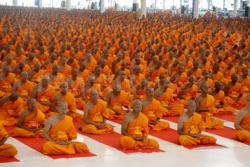Vipassana: Skillful Means
All people suffer from the same condition, they are like boats upon the ocean with no rudders; they have no means of direction. Vipassana provides that direction, but it is not only a means of ‘seeing clearly’, it is also a skillful means that needs to be understood correctly.
This skillful means, the core of vipassana, is exactly the same for all meditators, whether beginners or those already fully aware. Providing that the meditator has developed the basic skills involved in vipassana development, the most effective part of vipassana is just one action, one skill, which eventually leads to the cessation of all forms of suffering.
Practicing like an Arahant
When meditators first begin the practice they develop two skills, samadhi, concentration, fixing the mind upon the breath, and sati, mindfulness, being aware of and noting the phenomena in the mind as they arise. Then, when they have sila and samadhi, pannya arises and they are then able to see the phenomena arising in their minds as unsatisfactory, impermanent and not belonging to a self. This part of vipassana development is ‘seeing clearly’, developing and using pannya.
Thus, we can say that the first path is primarily concerned with the development of pannya and the early stages of letting go; seeing the true nature of phenomena that arise, and seeing that ‘self’ is simply an illusion formed by a mind process involving the 5 khandas (aggregates). Along the way, meditators begin to develop the real skill in vipassana, namely letting go, and it is this letting go that contains the real secret, the core of vipassana’s skillful means.
When someone is very angry, there is little point in telling them to let go of their anger because letting go is usually impossible under such circumstances, and they will probably get angry with you for even suggesting it. Therefore, letting go has to be correctly understood. When we develop vipassana, we come to realize that letting go is in two parts. The first part comes from sati, mindfulness, we have to be able to note what has arisen in the mind. Thus, if we are angry we have to be able to note anger, this means that we have completed the first part, and then we use the core skill of vipassana and redirect the mind to another object, the breath.
Here, using anger, a somewhat large monster to deal with, may be a little overwhelming, but it serves the purpose of showing that just the idea of letting go is not enough (just as the usual idea of having mindfulness for most meditators is not enough without noting); you have to develop the two-part skill of noting and redirecting the mind. This redirecting, or direction, is the real secret to vipassana development; it is the skillful means. We are able to let go of all phenomena by noting and then directing the mind to another object.
From this, we can see that vipassana is not about mind control, we cannot possibly control any phenomena arising in the mind. Vipassana is about developing direction, the ability to redirect the mind away from all sources of suffering. What meditators develop in their practice becomes the skill they can then use in any situation; to be aware of the situation, noting, noting, and then to let go and redirect the mind. For beginners this direction is to the breath, later it becomes the path knowledges, and finally it becomes nirvana itself; giving everything to the void.
For Arahants, vipassana has been developed to perfection, thus for them it works all of the time with little effort. While they do not experience such emotions as anger as their minds have realized nirvana, they do experience bodily feelings of pain, feeling hot, feeling cold, feeling tired, and feeling the initial need to breathe when developing Nirodha Samapatti. In all cases they practice exactly the same as beginners practice. They move the direction of the mind away from these feelings, and in their case they give everything to nirvana, the void.
Beginners have something else to hone their skills upon, namely pain. Pain is the ten-wheeled truck coming down your mind; easy to spot, and relatively easy to avoid. The nature of the mind is that it can only experience one thing at a time, so once you have noted the pain and directed the mind back to the breath it stops for a moment. Then, it will come back again and you repeat the process. After doing this for about 99 times the pain then runs away in disbelief!
As for anger, a beginner’s samadhi, sati, and redirection to the breath will probably not save them while doing sitting meditation. It is worth a try, but walking meditation, directing the attention of the mind to the feet, as far away from the heart as possible, is much more effective. In ordinary life situations we face the possibility of not only attachment to our own anger (which arises from some other attachment), but also attachment to other people’s anger. The best solution is to say nothing, walk away and go and do something else until it goes away by itself.
Once a meditator has completed the first path then dealing with anger becomes a more realistic proposition, as they then have the first path knowledge (yahn) to direct their anger to. Meditators do not need a lot of pannya to realize that anger is very unsatisfactory in nature, but many lack the mindfulness to see it arising and also have strong habits of attachment to it, particularly in its more subtle forms.
Thus, if good samadhi and sati are not developed in the initial stages of vipassana the meditator will come to a stage where they just keep going up and down instead of progressing. Therefore, vipassana should be understood as a skillful means of avoiding suffering, and meditators need perseverance in developing these skills. All people have slightly different natures, but there is nothing whatsoever to stop them from developing these skills, other than their own thoughts, which is thinking, thinking. The way to become skillful is more and more practice, and the usual idea of meditation is then transformed into a source of wisdom and an increasingly effective means of letting go.
- Note that the method taught to Vipassana Ajarns in Thailand differs from the traditional Burmese method in several ways. Continuous noting of a feeling or phenomenon is replaced by noting and then bringing the mind back to the breath. This develops a more ruthless approach to letting go (non-attachment) and direction; also recognizing that there are some feelings that will not go away by continuous noting. In general, the specifics of a particular feeling are regarded as inconsequential and all are noted as feeling, feeling.
In walking meditation, only the first method is used, lifting, placing, rather than all six. In this method, awareness of the intent to move is essential before all movement. This includes not only during walking meditation (intent to move, intent to turn), but also changes in posture from sitting to walking and all movement throughout the day. Thus, all movement has to be carried out slowly for a period of several months. Being aware of intent is of the utmost importance because it is the root cause of all karma.
Manjushri’s sword is sharp: A vicious blade that slits through your inner demons with one blow.
In Buddhist thought, it is this sword that one uses to cut through ignorance, and reveals the true nature of reality.
Manjushri, the bodhisattva of wisdom, is associated with prajna, a wisdom that is not confined by knowledge and concepts.
In Seth Godin’s book Linchpin, he describes prajna as seeing the world as it clearly is.
Do we see the world as it clearly is?
Right now we do not. We see the world through a lens; our lens. Another name for this lens is simply your mind.
Your mind is originally without form, therefore it can be molded by the experiences in your life: Your family, the culture you live in, the books you read, and so on. These collective experiences form your lens, which ultimately form your point of reference.
It is through this lens that all hopes and fears are created. In the absence of this lens, all things are possible and free – this is the original state of your mind.
However, through the conditioning imposed upon our original formless mind, we create a lens which filters through what we see and conceptualizes it, placing it into a context that fits with our preconceived notions.
Ok, that was a mouthful. Put simply, when we see something new we automatically compare it and analyze it in the context of our previous knowledge.
For example, if we have a 9-5 job and our culture and friends consider this the norm, we will see other opportunities, such as working 4 hours a week, or quitting our job and trying to start a business, as scary, abnormal, or risky.
Yet, if everyone in our culture worked 4 hours a week, we would consider that fairly safe and normal.
Which one is true? Neither is right or wrong.
The issue is that they both feel different because of our lens, our mind, and our previous experiences. This makes us categorize them as true or false, right or wrong and risky or safe.
Now, to achieve success in the manner in which we truly desire, often we have to cut through our lens. This is where Manjushri’s potent blade and the wisdom of prajna comes in.
Just like cutting anything, from wood to a piece of paper, you have to first see what is being cut clearly. There is no point in blindfolding yourself before you chop wood.
Therefore, you must first bring your lens, which is the true harbourer of all your destructive hopes and fears, into clear focus.
Simple right? Well…..
There are many tools for this: Meditation, deep reflection, psychiatry, yoga and other methods. All these can potentially harness the power of Manjushri’s sword.
With the use of these methods, your lens will get weaker and weaker. The original state of reality, free from fear, will start to reveal itself. The bumps on the road to success will start to dissipate, and you will be able to walk confidently towards your fate.
You will be free to experience reality as it truly is, prajna.
Harnessing the power of the sword is not easy. It is much easier to just go with the flow of your comfort zone. However, just imagine being free to pursue your goals without fear; Imagine the fear of failure or criticism disappearing—the fear of success, and eventually all fears, vanishing into thin air.
This is the power of Manjushri’s sword.





